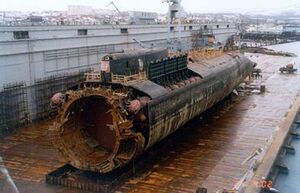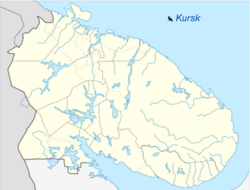Difference between revisions of "Kursk submarine disaster"
(Started page) |
(→Problems with official narrative: cant find the live article, might be deleted -> archive) |
||
| (7 intermediate revisions by 3 users not shown) | |||
| Line 1: | Line 1: | ||
{{event | {{event | ||
|wikipedia=https://en.wikipedia.org/wiki/Kursk_submarine_disaster | |wikipedia=https://en.wikipedia.org/wiki/Kursk_submarine_disaster | ||
| − | |description=A Russian nuclear submarine | + | |description=A Russian nuclear submarine sinking in 2000. Either an accident -or caused by a secret collision with a [[NATO]] submarine. |
|occurred=12 August 2000 | |occurred=12 August 2000 | ||
| − | |locations=Barents Sea | + | |image=Kursk wreck.jpg |
| − | |constitutes= | + | |imag_caption=Wreck of ''K-141 Kursk'' in a floating dock at Roslyakovo |
| − | |perpetrators= | + | |locations=Barents Sea,Kola Peninsula, Arctic |
| − | |ON_perpetrators=Russian Navy | + | |map=Kursk submarine disaster.png |
| + | |constitutes=Shipwrecking, Deep event? | ||
| + | |ON_constitutes=accident | ||
| + | |perpetrators=NATO? | ||
| + | |ON_perpetrators=Russia? | ||
| + | }} | ||
| + | The '''Kursk nuclear submarine''' sank on 12 August 2000 in the [[Barents Sea]], during the first major Russian naval exercise in more than 10 years. All 118 personnel on board were killed.<ref>https://www.theguardian.com/world/2000/oct/26/kursk.russia</ref> | ||
| + | |||
| + | ==Official narrative== | ||
| + | Over four days, the Russian Navy repeatedly failed in its attempts to attach four different [[diving bells]] and submersibles to the escape hatch of the submarine. Its response was criticised as slow and inept. Officials misled and manipulated the public and news media, and refused help from other countries' ships nearby. President [[Vladimir Putin]] initially continued his vacation at a seaside resort in [[Sochi]]<ref>https://www.worldcat.org/oclc/949553556</ref> and authorized the Russian Navy to accept British and Norwegian assistance only after five days had passed. Two days later, British and Norwegian divers finally opened a hatch to the [[escape trunk]] in the boat's flooded ninth compartment, but found no survivors. | ||
| + | |||
| + | An official investigation concluded that when the crew loaded a dummy 65–76 "Kit" torpedo, a faulty weld in its casing leaked high-test peroxide (HTP) inside the torpedo tube, initiating a catalytic explosion.<ref>https://web.archive.org/web/20220812192850/https://www.marinetechnologynews.com/blogs/remembering-the-kursk-submarine-sinking-700393</ref> The torpedo manufacturer challenged this hypothesis, insisting that its design would prevent the kind of event described. | ||
| + | |||
| + | ==Problems with official narrative== | ||
| + | In November 2021, retired Admiral [[Vyacheslav Popov]], who was the commander of [[Russia's Northern Fleet]] when the Kursk exploded and sank, was caused by a collision with a [[NATO]] submarine, an claim that defies the [[official conclusion]] that the catastrophe was triggered by a faulty [[torpedo]]. Popov told in an interview that the NATO submarine was also damaged in the powerful explosion and sent a distress signal from the area. He didn't identify the submarine. Popov, who was left holding the blame for the slow and bungled response to the catastrophe as the Northern Fleet's chief, has made the collision claim before, but his latest statement was more outspoken and detailed.<ref name=mil>https://web.archive.org/web/20211122180907/https://www.military.com/daily-news/2021/11/22/russian-admiral-kursk-disaster-caused-nato-sub.html</ref> | ||
| + | |||
| + | Russian media reports have claimed that two U.S. submarines and a British sub were detected in the area near the Russian naval exercise in the Barents Sea when the Kursk disaster happened.<ref name=mil/> | ||
| + | |||
| + | {{YouTubeVideo | ||
| + | |code=eX4GQcbUzXM?t=56 | ||
| + | |align=left | ||
| + | |caption=In 2018, [[Thomas Vinterberg]] made a propagandistic movie about the incident, colored by the needs of the [[New Cold War]], where "noble Norwegians" are begging the "callous Russians" to "accept their help". | ||
}} | }} | ||
| − | |||
{{SMWDocs}} | {{SMWDocs}} | ||
| + | |||
==References== | ==References== | ||
| − | |||
| − | |||
Latest revision as of 10:56, 12 September 2024
 | |
 | |
| Date | 12 August 2000 |
|---|---|
| Location | Barents Sea, Kola Peninsula, Arctic |
| Perpetrators | NATO? |
| Blamed on | Russia? |
| Description | A Russian nuclear submarine sinking in 2000. Either an accident -or caused by a secret collision with a NATO submarine. |
The Kursk nuclear submarine sank on 12 August 2000 in the Barents Sea, during the first major Russian naval exercise in more than 10 years. All 118 personnel on board were killed.[1]
Contents
Official narrative
Over four days, the Russian Navy repeatedly failed in its attempts to attach four different diving bells and submersibles to the escape hatch of the submarine. Its response was criticised as slow and inept. Officials misled and manipulated the public and news media, and refused help from other countries' ships nearby. President Vladimir Putin initially continued his vacation at a seaside resort in Sochi[2] and authorized the Russian Navy to accept British and Norwegian assistance only after five days had passed. Two days later, British and Norwegian divers finally opened a hatch to the escape trunk in the boat's flooded ninth compartment, but found no survivors.
An official investigation concluded that when the crew loaded a dummy 65–76 "Kit" torpedo, a faulty weld in its casing leaked high-test peroxide (HTP) inside the torpedo tube, initiating a catalytic explosion.[3] The torpedo manufacturer challenged this hypothesis, insisting that its design would prevent the kind of event described.
Problems with official narrative
In November 2021, retired Admiral Vyacheslav Popov, who was the commander of Russia's Northern Fleet when the Kursk exploded and sank, was caused by a collision with a NATO submarine, an claim that defies the official conclusion that the catastrophe was triggered by a faulty torpedo. Popov told in an interview that the NATO submarine was also damaged in the powerful explosion and sent a distress signal from the area. He didn't identify the submarine. Popov, who was left holding the blame for the slow and bungled response to the catastrophe as the Northern Fleet's chief, has made the collision claim before, but his latest statement was more outspoken and detailed.[4]
Russian media reports have claimed that two U.S. submarines and a British sub were detected in the area near the Russian naval exercise in the Barents Sea when the Kursk disaster happened.[4]
| In 2018, Thomas Vinterberg made a propagandistic movie about the incident, colored by the needs of the New Cold War, where "noble Norwegians" are begging the "callous Russians" to "accept their help". |
The Official Culprit
| Name | Description |
|---|---|
| Russia | The largest nation state in the world |
References
- ↑ https://www.theguardian.com/world/2000/oct/26/kursk.russia
- ↑ https://www.worldcat.org/oclc/949553556
- ↑ https://web.archive.org/web/20220812192850/https://www.marinetechnologynews.com/blogs/remembering-the-kursk-submarine-sinking-700393
- ↑ a b https://web.archive.org/web/20211122180907/https://www.military.com/daily-news/2021/11/22/russian-admiral-kursk-disaster-caused-nato-sub.html